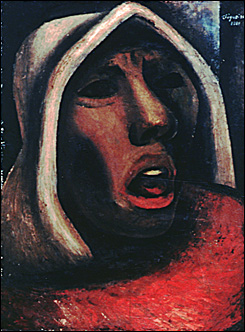
El grito, 1931. David Alfaro Siqueiros (Mexican). Mexico. Encaustic on burlap: 34" x 24" unframed. Purchased with funds provided by the Robert C. and Helen Kleberg Foundation.
The experience of the Revolution convinced Siqueiros of the need for a politically committed art. His manifesto called for a monumental public art based on socialist ideals and modernist forms. As a muralist, he created a powerful style by using rapid, bold lines and exaggerated perspective. The central theme in his work is the oppression of the Mexican lower classes. In 1922, Siqueiros organized the Union of Technical Workers, Painters and Sculptors with Rivera and others. His largest mural, The March of Humanity was begun in 1964 after he served a four year prison sentence for political militancy. The mural was installed in the Siqueiros Cultural Polyforum in Mexico City.
Siqueiros painted murals on public and private buildings in Los Angeles, Buenos Aires, Cuba, and Chile. He was awarded the National Prize for Art from the Mexican government in 1966 and the Lenin Peace Prize from the Soviet Union in 1967. He was also an accomplished easel painter.